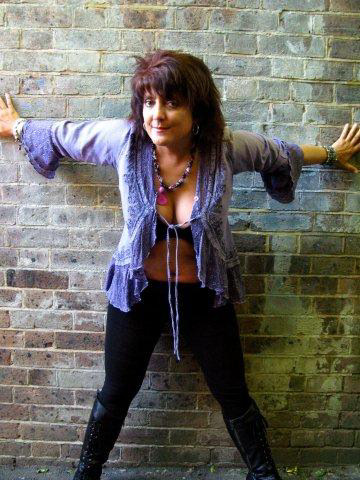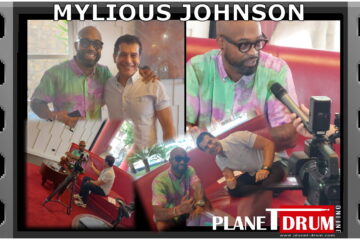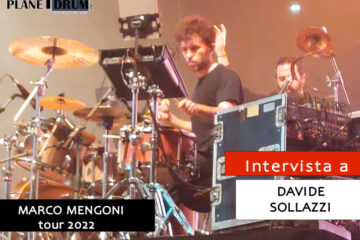Joanne Ruocco, interviewed by Alice Frances Wickham

Jo Jo Ruocco, who grew up in New Jersey, started as a percussionist at a really early age: 13 to be precise, drumming with Jazz giant Duke Ellington! She went on to provide drummery for Chuck Berry at the age of 16, then went on to play with Bobby Womack, Billy Ocean, Ronnie Wood, The Style Council, amongst many others! We hear about her great career, and her tastes in music across the decades.
Q: So, JoJo, do you want to tell me a little bit about your musical background, how it all began?
A: I started out when I was thirteen years old in Long Island, as a guest with the Mercer Ellington orchestra. I was a prodigy! (Laughs). This was just after Duke Ellington died; it was a fundraiser for cancer awareness. I went up and did a drum solo on Satin Doll, with Ella Fitzgerald singing in the foreground. After that, I was approached to go on the road with Mercer Ellington but sadly, I had to finish schooling. Further down the road I got a call out of the blue from the William Morris agency asking if I would be able to play with Chuck Berry. It was at Hunter College, NYC. That same night I met with Chuck. It was phenomenal. The audience was terrific. Then I guested again with Chuck, at another performance and then another. We played quite a number of gigs. This was in my teen years. Chuck had to do some time in prison over tax evasion, but we kept in touch, Chuck writing to my home address. So that was quite precious. He was like a mentor. Then I went on to study Jazz and Rock drumming, which I love.
Q: What techniques did you learn, and who were your most inspirational teachers?
A: I started off with Joe Morello of the Dave Brubeck band. So it was constant, versus variable techniques, which people consider to be linear. Back in the bee-bop it’s what they were doing naturally. Further back, African drumming ruled the day, everyone puts their own little header or name to it. After Joe Morello, I began with Peter Erskine, of Weather Report. I was at Right Track Studios working as a tape assistant, Pete came in; he was recording with ‘Steps Ahead’, I started studying with him. Pete was a master; he taught me some subtleties of tone, and how to play cymbals as if painting a picture.
Q: What was the most important thing you learned?
A: I would say, style, and drum mannerism from Pete Erskine, so gentle and controlled, with the Hi-Hat, opening and closing on the eighth notes, and various syncopation patterns with the right hand. Here’s this guy working with Weather Report and all these other Jazz musicians I admired, yet he was so approachable. Pete showed anything is possible, it doesn’t matter where you come from, or what your background. It shouldn’t matter if you’re from America, or whatever country, or if you’re rich or if you’re poor. The key element is drive, and perseverance.
Q: and technically, as a stylist?
A: With Pete, I picked up sensational dotted eight and sixteenth notes, variations of 5/4 and 7/4 time signatures, so that was really good. Learning, about odd time meters.
Q: Can you give me the kind of music you would apply that to?
A: For instance ‘Birdland’. If you listen to that track from Weather Report, that’s really an excellent track. Or ‘Heavy Weather,’ that album is without a doubt, one of my favorite albums.
Q: What style of drumming is that?
A: Jazz Fusion. After Erskine, I studied Afro Cuban with Montego Joe, and later on I met up with Glenn Webber who taught Danny Gotleib, the drummer of Pat Metheney group. Glen was one of my favorite drum teachers. With Glen we picked up where Joe Morello left off. We picked up where Peter Erskine left off, before he went back on the road. Basically, I went through the full repertoire from Jazz, and went on from there, all the folkloric Afro Cuban percussion rhythms, Congas, Timbale, Bongos, and orchestrated percussion.
Q: Skin drums are very widespread these days, ethnic drums like the Bodhran, and the Congas. What advice would you offer learners starting out on these drums?
A: With Congas it’s getting your tones, open, closed, muffled, or slap sounds, and then various Afro Cuban Folkloric rhythms, such as the guaguanco against 2/3 or 3/2 son clave pulses. Also, rumba and palito patterns and tumbao. Next is the Timbales, learning rhythms such as Songo, Cascara and my favorite the Mozambique. With the Bodhran, it’s the positioning of the drum, and learning to relax your wrist motion. Listen non-stop to Irish Jigs & Reels, learning their complex meters.
Q: You mean the timings?
A: Yes. You’re looking at a variation of 4/4, or half-time, and then you’re going to 6/8. It’s applying it, coming in and out of different meters, and applying those techniques to commercial music; giving you that edge. With Glen we started going over the tabla drums, and I just thought for learning the vocal points, the vocabulary of tabla, because it’s about understanding the language. If you can say it, you can play it.
Q: Can you give an example of some great drummers using these techniques?
A: Yeah, Trilok Gurtu. So he would use the tabla drums. He plays it amazingly, he sits on his knees, you know, he can play the kit on his knees, and bring in the tabla drums.
Q: I thought you were mainly a set drummer.
A: I was back in New Jersey, when I got a call out of the blue from a London agent asking if I want to go on tour an artist called Howard Carpendale who is signed to Polydor. I accepted the challenge.
It was a sellout tour, 55,000 seater halls, throughout Germany. I had the percussion chair, working on Tympanis, Tubular Bells Glockenspiel, and Congas, and drums. I hadn’t done Tympanis or Bells since college! So I booked private sessions Glen Weber of the New Jersey School of Percussion, for a five days crash course and we went through everything! That was a lot of fun overcoming the obstacles in such a short space of time! So here I am, with a ten-piece Latin Percussion cage around me, and a 48inch diameter gong. One night, the musical director pissed me off, so I put all my anger into the mallet. When I hit that gong for emphasis, it split right in half! Talk about PMS!
Q: You sound like Bruce Lee!
A. (Laughs) Can you believe? Everyone got a laugh out of it, and afterwards the musical director and I became best of friends.
Q: That’s funny! So for a kid starting out, what’s the first thing she needs to do?
A: First thing you do, listen to the music you like, and never underestimate your ear. So to answer your question, I would say play the music you love. But you have to then say, ‘okay, where do I want to go with this? What do I want to do?’ So, for example, do you want to become a jingle session player? Then you better brush up on chart reading. Do you want to be a pit drummer (theatre) on a Broadway show; again, it’s a combination of listening ear, and sight-reading. I would recommend listening to your big band guys like, Gene Krupa, ‘Sing, Sing, Sing,’ Max Roach, Jon Bonham from Led Zeppelin, listen to his snare drum , bass drum and high hat, variations, people just copy that and use it in dance tracks, hip hop, rap and the rest of it. You know where those really cool rhythms came from? Jon Bonham! And for Jon Bonham before that? African. And not just stop at drumming but also percussion. At the end of the day that’s what percussion is, anything that percusses! That includes keyboards.
Q: What about Charlie Watts.
A: He always gives you the feeling that he’s always one hairline out, but he’s not. He gives you that sluggish riff, with ghost notes in his grooves, and that’s what subconsciously gets the listener. So he’s brilliant.
Q: And you’re writing a memoir?
A: Yeah, a very unique setting. My mother was in PR so she knew a lot of famous types, people like Woody Allen, Roy Ayres, the Jazz instrumentalist, various different sorts. Growing up with her was off the wall, but a lot of fun! I had to push to be heard. I didn’t want part of that; I wanted to make my own path. So, after I finished school, I took two suitcases, came over to England, with a pocketful of dreams and a lot of determination. As soon as the wheels hit the pavement at Heathrow, – I had nowhere to go, nowhere to stay – I said, ‘I’m going to make this work.’
From late 1980s Joanne went on to play with Paul Weller, Kylie Minogue, Sinead O’Conner and the inimitable Ronnie Wood. Read more in her fascinating book, ‘Beautiful Confusion’, out soon. Publisher TBC


